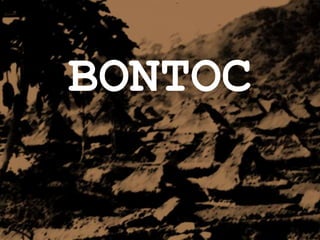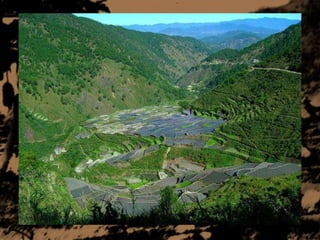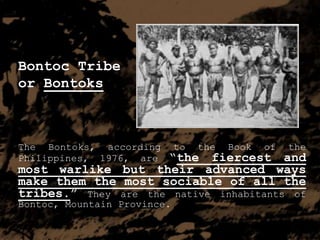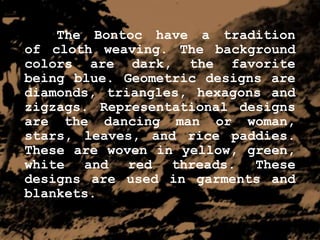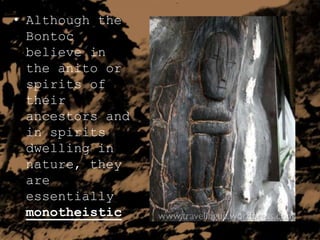Architecture in Bontoc
- 1. BONTOC
- 4. • 3rd class municipality and the capital of Mountain Province, Philippines • the historical capital of the entire Cordillera region since the inception of governance in the Cordillera
- 5. • has a population of 24,798 people in 5,035 households • politically subdivided into 16 barangays
- 6. • The local economy depends largely on small trades and agriculture • Its biggest economic potential is tourism with its smaller rice terraces in Barangay Bay- yo, Maligcong and other areas.
- 8. "bun" (heap) and "tuk" (top) Mountain = Bontoc
- 9. Bontoc Tribe or Bontoks The Bontoks, according to the Book of the Philippines, 1976, are “the fiercest and most warlike but their advanced ways make them the most sociable of all the tribes.” They are the native inhabitants of Bontoc, Mountain Province.
- 11. The Bontoc have a tradition of cloth weaving. The background colors are dark, the favorite being blue. Geometric designs are diamonds, triangles, hexagons and zigzags. Representational designs are the dancing man or woman, stars, leaves, and rice paddies. These are woven in yellow, green, white and red threads. These designs are used in garments and blankets.
- 17. • The pre-Christian Bontoc belief system centers on a hierarchy of spirits, the highest being a supreme deity called Lumawig.
- 18. • Although the Bontoc believe in the anito or spirits of their ancestors and in spirits dwelling in nature, they are essentially monotheistic
- 19. • The Bontoc also believe in the "anito"—spirits of the dead who must be consulted before anything important is done.
- 20. Literary Arts • riddles, proverbs, aphorism, so ngs, tales, legends, and myths
- 21. “Wada san duay sing-anag-i menkasidkugda” There are two brothers, they turn their backs on one another. EARS “Mo madsem maannaannawa mo pay mapat-a ngumadan si tubong” (Abek) A bamboo tube by day, by night a sea. MAT
- 26. • Each ato has: - 15 to 50 houses - Communal center • chap-ay (circular open space paved with flat stones) • fawi (house where old men gather) • pabafunan (dormitory for young men and boys in their adolescence) • olog (dormitory for girls)
- 28. Parts of Fayu • Falig (granary) • Cha-la-nan (through the doorway one enters the ground floor, include s the space under the granary) • Ang-an (sleeping compartment)
- 29. FAYU • Bontoc house • The basic form is like that of the Ifugao house except that the house cage serves as a granary
- 31. The traditional Bontoc house was made of wood or cogon grass. It was pyramid- shaped or A- shaped. It was small and had only one bedroom such that other members of the family could not be accommodated.
- 33. Aside from the bedroom, the traditional Bontoc house had another room with different divisions; kitchen, a space for dining and, at the same time, for receiving visitors; a space for some parallel piece of wood nailed together to serve as a multi-purpose table, below is a space for chicken coops, garden tools, gathered camote leaves, root crops, and baskets; a space above the bedroom is for pots, jars, native plates, wooden dipper and ladle. Since there was only one bedroom, the male teen-agers had to sleep in the ato while the female counterparts would go to the ulug.
- 36. A house within a house…
- 37. In the Bontoc house, levels and compartments clearly define the function of spaces. Areas for working, cooking, sleeping, and storage even have specific names.
- 39. Carmona, Paul John S. Faner, Carla HSTARC4|DAR3
Editor's Notes
- #11: Traditional clothing leave both males and females bare above the waist
- #13: Traditional clothing leave both males and females bare above the waistThe tattoo used to be a prestige symbol, worn only by the headhunter. However,it is now purely ornamental.
- #15: Baskets
- #18: Lumawig personifies the forces of nature and is the legendary creator, friend, and teacher of the Bontoc. A hereditary class of priests hold various monthly ceremonies for this deity for their crops, the weather, and for healing.
- #20: Ancestral anitos are invited to family feasts when a death occurs to ensure the well-being of the deceased's soul. This is by offering some small amount of food to show that they are invited and not forgotten.
- #30: Bontoc houseThe basic form is like that of the Ifugao house except that the house cage serves as a granary Parts of fayu:Falig(granary)Cha-la-nan (through the doorway one enters the ground floor, includes the space under the granary)Ang-an (sleeping compartment)
